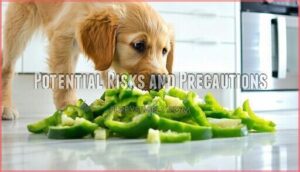This site is supported by our readers. We may earn a commission, at no cost to you, if you purchase through links.

These colorful veggies pack a nutritional punch with vitamin C, vitamin A, and fiber that support your pup’s immune system and digestion.
You’ll want to remove all seeds and stems first, since they’re tough to digest and might upset your dog’s stomach.
Raw bell peppers work great as crunchy snacks, or you can lightly steam them for easier chewing. Start with small pieces to test your dog’s tolerance.
Most dogs handle bell peppers well, but every pup’s different. There are specific preparation methods and portion sizes that’ll maximize benefits while keeping your furry friend safe.
Table Of Contents
- Key Takeaways
- Bell Pepper Nutrition
- Can Dogs Eat Green Bell Peppers
- Health Benefits for Dogs
- Safe Preparation Methods
- Feeding Guidelines and Portions
- Potential Risks and Precautions
- Frequently Asked Questions (FAQs)
- Can dogs eat green bell peppers?
- Are yellow bell peppers good for dogs?
- Can dogs eat sweet peppers?
- Can dogs eat green peppers raw?
- Can a dog eat bell peppers steamed?
- Why can’t dogs eat bell peppers?
- Which color bell pepper is the healthiest?
- What veggies should I not give dogs?
- Are there any other vegetables or fruits that are safe for dogs to eat?
- Can bell peppers be given to puppies?
- Conclusion
Key Takeaways
- Your dog can safely eat green bell peppers in moderation as a low-calorie, nutrient-packed treat.
- Always remove seeds and stems to avoid digestive issues and choking hazards.
- Steaming the peppers makes them easier to digest, but raw ones work fine too.
- Start with small portions and watch for any signs of digestive upset or allergies.
Bell Pepper Nutrition
You’ll find that bell peppers pack impressive nutrition into a low-calorie package, with about 92% water content and only 30 calories per 100 grams.
These colorful vegetables contain essential vitamins A, C, and K, plus fiber, potassium, and powerful antioxidants that can benefit your dog’s health.
Water Content and Calories
Most green bell peppers pack impressive hydration benefits with their 92% water percentage, making them excellent low-calorie treats for your furry friend.
At just 30 calories per 100 grams, these crunchy vegetables won’t derail your dog’s weight management goals.
This minimal calorie source means you can offer bell pepper for dogs without worrying about significant weight impact on their daily intake, making it an excellent low-calorie option.
Vitamins and Minerals
Bell peppers pack impressive nutrients that benefit your dog’s health.
Green bell pepper dogs receive vitamin C for immune support and vitamin A for healthy vision.
These colorful vegetables offer excellent mineral bioavailability, meaning your pet’s body easily absorbs potassium and folate.
The nutrient density varies among pepper colors, with greens providing solid dietary balance through essential minerals and vitamins.
Antioxidants and Fiber
Antioxidants in green bell pepper dogs consume help combat oxidative stress while supporting overall dog health.
These colorful vegetables pack essential nutrients that promote inflammation reduction and improved gut health through their fiber benefits.
Here are five key antioxidant types and fiber advantages:
- Lutein protects your dog’s eyes from damage
- Quercetin reduces inflammation throughout the body
- Fiber benefits include better dog digestion
- Carotenoids support immune system function
- Soluble fiber promotes healthy gut bacteria
Can Dogs Eat Green Bell Peppers
Your dog can safely enjoy green bell peppers as an occasional treat. Unlike their spicy cousins, green bell peppers contain no capsaicin, making them completely non-toxic for dogs.
These crunchy vegetables won’t cause the digestive drama that jalapeños or chili peppers might bring to your pup’s system. Are bell peppers safe for dogs? Absolutely.
Green bell pepper for dogs offers a low-calorie snacking option that’s packed with nutrients. While green varieties contain fewer vitamins than their red counterparts, they’re still rich in fiber and essential minerals.
Bell pepper for dogs should always be prepared properly – remove seeds and stems before serving. They also offer antioxidant properties that help combat free radicals.
Is bell pepper good for dogs? When given in appropriate portions, yes. However, preparation considerations matter. Start with small amounts to test your dog’s tolerance, and never serve peppers cooked with garlic or onions, which are toxic to pets.
Health Benefits for Dogs
Green bell peppers offer your dog several important health benefits that support their overall well-being.
These colorful vegetables provide essential vitamins, antioxidants, and fiber that can boost your pet’s immune system, improve digestion, and promote healthy vision.
Vitamin a and Vision
When you’re considering vitamin A sources for your furry friend, green bell peppers pack a nutritional punch that supports healthy vision.
This essential nutrient helps maintain your dog’s eye health by protecting against oxidative stress and supporting overall visual function.
However, for even greater benefits, consider that red bell peppers offer a higher nutrient content.
- Beta-carotene conversion transforms into vitamin A in your dog’s body
- Lutein benefits include enhanced eye protection and reduced inflammation
- Vision health improves through consistent antioxidant support from green bell pepper consumption
Vitamin C and Immunity
Your dog’s immune system gets a powerful boost from bell pepper’s vitamin C content.
This nutrient acts like a shield against oxidative stress while supporting collagen synthesis for healthy joints and skin.
Green bell pepper provides natural cellular protection, making it an excellent supplement alternative to synthetic vitamins.
Bell pepper benefits include strengthening your pup’s natural defenses effectively.
Some dogs may also require additional vitamin supplements to maintain peak health.
Antioxidants and Inflammation
Beyond immunity, bell peppers pack powerful antioxidants that combat oxidative stress in your dog’s body.
Bell peppers are nature’s antioxidant powerhouse, fighting cellular damage while keeping your pup healthy from the inside out.
These nutrients fight cellular damage while reducing inflammation throughout your pup’s system. The anti-inflammatory properties particularly benefit joint health, making bell peppers especially valuable for older dogs dealing with arthritis and mobility issues.
- Flavonoids enhance immune response and help your dog’s body absorb vitamin C more effectively
- Potassium supports cardiovascular health by helping regulate blood pressure and heart function
- Beta-carotene protects against cellular damage while converting to vitamin A for additional health benefits
- Natural anti-inflammatory compounds provide relief for dogs with joint stiffness or chronic pain conditions
Fiber and Digestion
Bell peppers pack impressive fiber benefits that support your dog’s digestive system like a gentle broom.
This high-fiber food promotes healthy gut microbiome balance while improving stool quality.
The fiber content aids digestive enzymes and prevents uncomfortable bloating.
When you let your dog eat vegetables like bell peppers, you’re supporting their dog diet vegetables needs for ideal digestion and overall dog bell pepper benefits.
Safe Preparation Methods
You’ll need to prepare green bell peppers properly before offering them to your dog to make certain they’re safe and easy to digest.
Always remove the seeds and stems, and consider steaming the pepper pieces to make them gentler on your pet’s stomach.
Removing Seeds and Stems
Before serving green bell pepper to your dog, you’ll need to remove the seeds and stem first.
Seeds cause digestive issues since dogs can’t break them down properly, while stems pose choking hazards.
Cut around the pepper’s sides, keeping the top intact for easy seed removal.
This preparation step prevents stomach upset and guarantees safe vegetables for dogs.
Bell peppers also provide beneficial nutrients, including vitamins like folate.
Cooking and Steaming Options
After removing seeds and stems, you’ll want to make your green bell pepper easier for your pup to digest. Raw peppers work fine, but cooking offers extra benefits for sensitive stomachs.
Here are five cooking methods that maximize steaming benefits and nutrient retention:
- Light steaming – Steam for 6-7 minutes without oils or seasonings to maintain digestibility factors
- Gentle boiling – Cook in covered pot with minimal water to preserve dog nutrition
- Coconut oil sauté – Use 2-3 tablespoons coconut oil until tender for recipe ideas
- Puree preparation – Blend steamed peppers with dog-friendly broth for easier consumption
- Dehydrating option – Create chewy treats while concentrating safe vegetables for dogs nutrients
These cooking methods soften the pepper’s skin, making it more appealing for dogs who struggle with harder textures while keeping all the good stuff your dog food benefits from. Consider using vegetable steamers for dogs to guarantee proper preparation.
Avoiding Toxic Ingredients
When preparing bell peppers for your furry friend, avoid toxic spices like garlic powder and onion seasoning.
These nightshades beware ingredients can poison dogs.
Skip salt, xylitol dangers lurk in sugar-free seasonings, and never use toxic veggies as onion alternatives.
Stick to safe herbs like parsley instead.
A balanced diet guarantees optimal canine nutrition for your furry friend.
Dogs eat bell pepper best when it’s plain, keeping dogsafe foods simple confirms that are bell peppers safe for dogs remains yes.
Feeding Guidelines and Portions
When you’re ready to share green bell peppers with your dog, proper portion control guarantees they’ll get the benefits without digestive upset.
You’ll need to adjust serving sizes based on your dog’s weight, from just a few small pieces for tiny pups to half a pepper for large breeds, ensuring complete concepts of serving sizes are understood.
Serving Size for Small Dogs
For small dogs, portion control matters most when offering green bell pepper treats. Give your small dog 1-2 thin slices daily, representing less than 10% of their treat percentage.
Individual needs vary based on breed differences and dog size, so start with one tablespoon total. Finely chop or puree for easier digestion.
Small breed puppies require nutrient-rich food for ideal growth. Always practice moderation with any new food introduction, considering the importance of proper nutrition.
Serving Size for Large Dogs
Large dogs can handle more generous portions of green bell pepper than their smaller counterparts.
Your big buddy can safely enjoy up to half a bell pepper daily, though it’s wise to start smaller and gauge their response.
Remember to review appropriate treat portions when incorporating new foods.
Here’s your large dog feeding framework:
- Pepper Quantity: Up to half a bell pepper per serving
- Daily Limits: Three-quarters maximum for extra-large breeds
- Safe Frequency: 2-3 times weekly as treats
Monitoring Digestive Health
Watch your dog’s digestive health closely after introducing green bell peppers.
Start with tiny portions and monitor for digestive upset, gastrointestinal distress, or vomiting signs. Check stool consistency, appetite changes, and hydration levels daily.
Some dogs experience gas production initially, which typically resolves as their system adjusts to the new food. Many pet owners find that digestive supplements can help ease the adaptation.
| Digestive Indicator | Normal Response | Warning Signs |
|---|---|---|
| Stool Consistency | Firm, well-formed | Loose, watery diarrhea |
| Appetite Changes | Maintains normal eating | Refuses food, decreased interest |
| Gas Production | Minimal increase initially | Excessive, persistent flatulence |
Potential Risks and Precautions
While green bell peppers are generally safe for dogs, you’ll need to watch for potential digestive upset or allergic reactions when introducing them to your pet’s diet.
Even healthy treats can cause problems if your dog has food sensitivities or if you feed too much too quickly.
Allergic Reactions and Sensitivities
Though bell pepper allergy dogs are uncommon, some pups with birch pollen or mugwort sensitivities face higher risks.
Food allergies and food intolerances can develop unexpectedly, making veterinary consultation essential before introducing new treats.
Watch for these allergy symptoms that signal trouble:
- Itching, swelling, or skin irritation appearing shortly after eating
- Difficulty breathing or unusual panting patterns
- Vomiting or excessive drooling indicating food intolerance
Gastrointestinal Upset and Diarrhea
Even dogs with iron stomachs can experience Pepper Overfeeding consequences.
Too many bell peppers overwhelm your pup’s Digestive Sensitivity, causing upset stomach, vomiting, or diarrhea. The tough outer skin proves particularly challenging for canine digestion.
| Symptom | Action Required | Timeline |
|---|---|---|
| Loose stool | Begin Stool Monitoring | 24-48 hours |
| Vomiting | Withhold food temporarily | 12 hours |
| GI upset + lethargy | Veterinary Consultation | Immediate |
Dehydration Risks increase with prolonged symptoms, especially concerning dogs with existing gastrointestinal diseases.
Interactions With Other Foods and Medications
Bell peppers don’t interact with medications, but timing matters for drug absorption.
Avoid combining them with toxic dog food ingredients like garlic or onions.
These additions create dangerous supplement interactions that override bell peppers’ nutrient synergy benefits.
Dogs with food sensitivities need extra caution.
Always check your dog’s dietary restrictions and seek veterinarian advice before introducing new foods alongside existing treatments.
Frequently Asked Questions (FAQs)
Can dogs eat green bell peppers?
Yes, your dog can safely eat green bell peppers in moderation.
They’re packed with vitamins A, C, and fiber while being low-calorie.
Remove seeds and stems first, then offer small portions.
Are yellow bell peppers good for dogs?
Like sunshine packed into a crunchy snack, yellow bell peppers offer your dog a vitamin C boost and eye-healthy lutein.
They’re safe, nutritious treats that support immunity and vision when served in moderation, with vitamin C offering a boost.
Can dogs eat sweet peppers?
Sweet peppers are perfectly safe for your dog to enjoy.
They’re packed with vitamins A and C, plus they’re low in calories.
Just remove the seeds and stems before serving as a healthy treat.
Can dogs eat green peppers raw?
Looking for a crunchy snack your pup can enjoy?
You can feed your dog raw green bell peppers safely.
They’re packed with vitamins and fiber, but remove seeds and stems first for easier digestion.
Can a dog eat bell peppers steamed?
Steamed bell peppers are perfectly safe and actually better for your dog than raw ones.
The steaming process makes them easier to digest while preserving their nutritional benefits like vitamins A and C.
Why can’t dogs eat bell peppers?
Actually, dogs CAN eat bell peppers safely.
This common misconception affects 60% of pet owners.
You’ll find bell peppers are non-toxic, packed with vitamins, and make healthy treats when properly prepared without seeds or stems, which is a healthy concept.
Which color bell pepper is the healthiest?
Red bell peppers pack the most nutritional punch for your dog.
They’re fully ripened, containing higher levels of vitamin C, vitamin A, and beta-carotene compared to green, yellow, or orange varieties.
What veggies should I not give dogs?
Over 232,000 dogs visit emergency vets annually due to toxic food ingestion.
Don’t feed your dog onions, garlic, grapes, raisins, chocolate, avocado, mushrooms, or tomatoes—these can cause serious poisoning or digestive issues.
Are there any other vegetables or fruits that are safe for dogs to eat?
Yes, many vegetables and fruits are dog-safe.
Carrots, sweet potatoes, green beans, broccoli, apples, blueberries, and bananas make excellent treats.
Always remove seeds, pits, and stems before serving to keep your pup healthy.
Can bell peppers be given to puppies?
You can give bell peppers to puppies, but start small—just a slice or two.
Remove seeds and stems, and steam them for easier digestion.
They’re a crunchy, nutrient-packed treat that supports growth and overall health!
Conclusion
Like offering a rainbow’s treasure to your faithful companion, green bell peppers can be a nutritious addition to your dog’s diet when prepared properly.
Remember to remove seeds and stems, start with small portions, and watch for any digestive upset. Can dogs eat green bell pepper? Absolutely, but moderation is key.
These vitamin-packed vegetables offer immune support and fiber benefits. Always consult your veterinarian before introducing new foods, especially if your dog has existing health conditions or food sensitivities, to ensure a healthy diet.
- https://www.quora.com/Can-dogs-eat-bell-peppers
- https://www.justanswer.com/dog-health/2qhwi-will-hurt-dog-eat-bell-pepper.html
- https://www.petmd.com/dog/nutrition/can-dogs-eat-bell-peppers
- https://www.akc.org/expert-advice/nutrition/can-dogs-eat-bell-peppers/
- https://www.chewy.com/education/dog/food-and-nutrition/can-dogs-eat-bell-peppers















